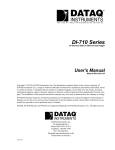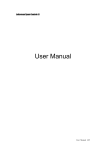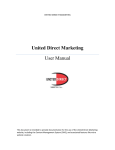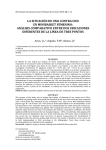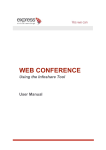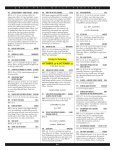Download RUSS WEINSTEIN - ICANN 48 in Buenos Aires
Transcript
BUENOS AIRES – Community Priority Evaluation (CPE) and Auction EN BUENOS AIRES – Community Priority Evaluation (CPE) and Auction Monday, November 18, 2013 – 17:15 to 18:45 ICANN – Buenos Aires, Argentina RUSS WEINSTEIN: So it's about 5:15. I'd like to get started now, if everybody could take their seats. Okay. So we're going to get started now. So if everyone could take their seats and end their side conversations, that would be appreciated. Okay, welcome. Thank you, everybody. This is the session for Community Priority Evaluation and new gTLD auctions. So if you're not here for this, I ask you to step outside, please. >> Could we have your attention, please? Excuse us. Thank you. RUSS WEINSTEIN: So I'm Russ Weinstein, senior manager on the gTLD program. And like I said, Community Priority Evaluations and new gTLD auctions are the topic for today. I have Larry Ausubel from Power Auctions, our auction provider, here with me, and Steve Chan our manager of new gTLD operations as well. Next. So the agenda for today is we'll give you an overview of where we are at so far with contention set resolution. We'll provide a Note: The following is the output resulting from transcribing an audio file into a word/text document. Although the transcription is largely accurate, in some cases may be incomplete or inaccurate due to inaudible passages and grammatical corrections. It is posted as an aid to the original audio file, but should not be treated as an authoritative record. EN BUENOS AIRES – Community Priority Evaluation (CPE) and Auction discussion on Community Priority Evaluation, or CPE, and then we'll open for discussion Q&A portion on CPE for about ten minutes or so, and then we'll move on to new gTLD auctions. I'll go through -- I'll go through the status update, readiness, some process and timeline information, and then I'll turn it over to Larry who will give you some simulation of the system and more explanation about ascending clock auctions, and then we'll open it back up for discussion topics that we talked about in the webinar a couple -- 11 days ago or so and then open it for general Q&A after that. Next. So current contention resolution status, you'll see the figures on the left represent the initial figures after the string similarity panel performed its evaluation. So we had 234 contention sets with 758 applications placed into contention. Currently we're about 201-we're at 201 contention sets with 657 applications in contention. And these figures do not account for the string confusion objection determinations yet. We've made Economist Intelligence Unit or EIU as we call them as the CPE panel and they're actively engaged on CPE. And as mentioned earlier, we have Power Auctions LLC as the auction provider. And just always a friendly reminder that auctions are expected to be the method of last resort to resolve string contention. You're always encouraged to resolve string contention amongst yourselves. With that I'll turn it over to Steve. Page 2 of 55 EN BUENOS AIRES – Community Priority Evaluation (CPE) and Auction STEVE CHAN: Thank you, Russ. So as Russ has mentioned, CPE is underway. It started on the 24th of October. There -- the evaluations are expected to take two to three months, and perhaps an extra two weeks to actually get results published on the CPE microsite. In terms of the evaluation pipeline, we have 2 that are actually in evaluation, 2 that are invited, and 28 that remain to -- they still need to become eligible to be invited. For the two that are in evaluation, if there are CQs necessary we expect them to be sent early to mid-December. And we could see first results as early as early January 2014. So as those 28 applications, community applications in contention, become eligible, they'll be invited on a weekly basis. And we will be updating the CPE microsite regularly with invitations and elections and, you can visit that URL for continued status updates. We often get questions about eligibility, so I just want to remind everybody what the eligibility requirements are for invitation. The community application itself must be self-designated per section 1.2.3 of the AGB. They must be an active string contention set. They must not have a pending change request, and they also must not be in a 30-day application comment window for an approved change request. In addition, all members of the set must also have completed evaluation, have Page 3 of 55 BUENOS AIRES – Community Priority Evaluation (CPE) and Auction EN no pending objections, have no unresolved GAC advice, and not be classified as high risk per the Name Collision Occurrence Management Plan. So next I just wanted to talk about process, specifically the invitation and notification process. As I mentioned earlier, we will be inviting eligible applications on a weekly basis. From the date of invitation they'll receive 21 days to both elect and also pay the 22,000 USD deposit. At the same time that we do the invitation, we'll also notify every other member of the contention set that they have been invited, and one other thing that we'll do, also do at the same time, is update the CPE microsite to reflect the invitation date. And why that's important is the -- is that application comments and correspondence, the due date for receiving those and to be taken into account by the panel, it needs to be received 14 days after the invitation date. Next -- sorry, I'll get a little closer. In terms of evaluation scope, all elements of the public portion of the application will be reviewed. They'll also be looking at application comments, letters of support and opposition, and also objection determinations. So I also wanted to talk a little bit about the CQ process. One of the main efforts that we're trying to do is have the panel validate letters of support. So validating letters of support is something that the panel will do proactively. They will reach out to the contacts as referenced in the letters of support or opposition. I Page 4 of 55 BUENOS AIRES – Community Priority Evaluation (CPE) and Auction EN know there's been a little bit of confusion. The contacts do not need to proactively reach out to the panel. The panel will reach out to the contacts. So in the event that the contact is not responsive, one of the things that we want to address in the CQs is have the panel reach out to the applicant and have them coordinate and have the contact actually hopefully respond. One other thing that's part of the scope for the CQs is that the applicant will have the opportunity to respond in the event that application comment, letters of opposition or objection determinations materially affect the scoring. So we -- we had correspondence going back and forth. The correspondence is not -- method is not intended to be a way to communicate back and forth between perhaps someone providing comments to the application. If the applicant has a -- or if the elements are affecting the scoring, then the applicant will have the opportunity to respond to them. And also, the applicant may be given a chance to clarify application responses, and that's clarify, not expand or change their answers. In regards to timing of CQs, they're expected to be roughly one month into the evaluation process, and consistent with initial evaluation, applicants will receive 28 days to respond to the CQs. This is a timeline that's also on our CPE microsite. It just gives you a rough overview of the evaluation process. It's consistent with what I was just talking about, the 21 days to elect and pay, the 14- Page 5 of 55 BUENOS AIRES – Community Priority Evaluation (CPE) and Auction EN day deadline for application comment and correspondence, approximately a month for evaluation, and if clarification -clarifying questions are issued and required, then the applicant gets one month to respond and there's an additional month for finalization and publication of results. So all in all -- all told, it's about two to three months for evaluation and publication of results. So that's actually my slides. I'm going to turn it over to question and answer. RUSS WEINSTEIN: So if there's any question and answer related to CPE we'd like to take it at this time, and there's a mic up here for the queue. ANDREW MERRIAM: Andrew Merriam, Top Level Design. Good afternoon. Real quickly on the issue of clarifying applications -- question of the original application. Will that be public? Their responses or what's being clarified? STEVE CHAN: Consistent with initial evaluation, it will be -- it will not actually be published. Page 6 of 55 BUENOS AIRES – Community Priority Evaluation (CPE) and Auction EN ANDREW MERRIAM: Will not be published. STEVE CHAN: It will not be published. ANDREW MERRIAM: I mean, the original application was published, so it seems that if significant change involved, publishing it might be relevant. STEVE CHAN: So as was indicated in the slide, the CQ process is not intended to allow significant change to the application. It's supposed to be a clarification, literally a clarification. ANDREW MERRIAM: Thanks. URS AROS: Hi, this is Urs Aros (phonetic) for InterNetX, an applicant for new gTLDs which are in contention sets with some community applications. I have a question concerning the notification and the comments. How is the notification of the other applicants going to take place? Is it going to be a letter? Is it going to be electronic notification? Page 7 of 55 BUENOS AIRES – Community Priority Evaluation (CPE) and Auction STEVE CHAN: EN So the notification to the other applicant in the contention set, they'll be communicated via the customer portal. They'll actually receive a case, effectively at the same time that we actually invite the eligible community applicant. URS AROS: Okay. So it's going to be an electronic -- STEVE CHAN: Electronic. URS AROS: Okay. Here we go. The comment, you said then you have a comment phase where you can comment on the application itself. I guess the comments have to be in electronical form as well. The question is, can anyone comment or does it have to have a relation to that application, and must the comment include proofs or other material stuff to underline the issue or is it just enough to do a comment? STEVE CHAN: So first, just a clarification. It's not necessarily a -- it's not a window for a comment. It's more of a deadline because even at this point you can actually still comment on applications. It's more of a deadline to give the panel a cutoff date so that they know what to take in account for their evaluation. Page 8 of 55 BUENOS AIRES – Community Priority Evaluation (CPE) and Auction EN In terms of who -- who is allowed to comment or correspondence, you don't have to have a relation. If you'd like to comment, you can comment. If you want to submit a letter of opposition, you can do that too, via correspondence. So it's whoever wants to comment. URS AROS: Okay. So far as I got it, the more substantial -- the more substantial we comment, in case we would do so, the more the panel is going to go into the material, is that right? STEVE CHAN: So the -- so the clarification -- Russ was just whispering to me. The panel -- it's their job to determine what is relevant and what needs to be taken into account and what might materially affect the score. URS AROS: Perfect. Thanks a lot. STEVE CHAN: Thank you. STEFAN LEGNER: Good evening, my name is Stefan Legner, also from InterNetX. My question is, who is the final authority defining that a Page 9 of 55 BUENOS AIRES – Community Priority Evaluation (CPE) and Auction EN community evaluation is really valid and it really targets a community or whether or not. STEVE CHAN: We select the Economist Intelligence Unit as the CPE panel. It's ultimately their responsibility to evaluate the -- the applicant against the CPE criteria that's in the Applicant Guidebook and also their supplemental evaluation guidelines. So it's ultimately their responsibility to come up with a determination. STEFAN LEGNER: So they will have the legally-binding final decision, whether it's a community application or not? RUSS WEINSTEIN: So the panel provides a recommendation to ICANN, similar to initial evaluation or any of the evaluation panels, and then ICANN will -- STEFAN LEGNER: So they -- RUSS WEINSTEIN: -- publish that. Page 10 of 55 BUENOS AIRES – Community Priority Evaluation (CPE) and Auction EN STEFAN LEGNER: So they make a presentation to ICANN and ICANN will decide? RUSS WEINSTEIN: Yes, they will present their results to ICANN and their rationale and provide ICANN with confidence that they performed the evaluation per the guidelines and the AGB and that they've done their job, and then ICANN will, if we believe that the job was done with the proper due diligence and to the requirements, then we will publish the results. STEFAN LEGNER: Okay. So there will -- you will be -- or the evaluator will be the one having the final decision. RUSS WEINSTEIN: As I stated earlier -- STEFAN LEGNER: Okay. DAN HALLORAN: This is Dan Halloran from ICANN legal. I just wanted to -- Russ, you're doing a great job answering the questions, but I just want to remind everyone that Russ is trying to give out general information and respond to the questions. Really, I mean, you're asking about legally binding final answers. Like, go read the Page 11 of 55 BUENOS AIRES – Community Priority Evaluation (CPE) and Auction EN Applicant Guidebook. That's what's final and binding. And we try to take care when we put out like written information and webinars or advisories that that's final and legal and binding. Or even there we sometimes give caveats, like we're trying to give out general information here and please refer to the Applicant Guidebook. So I just don't want you to feel like it's open season to kind of cross-examine Russ here and drill down. If you have specific detailed questions like that, I encourage you to put it through the customer service portal, and we can -- you know, then Russ can go to his attorneys, we can look carefully at the guidebook and give a carefully-crafted answer. Just want to put that caveat and help Russ out. He's trying to give you information here, but don't like pull out, you know, some word that he said and said oh, look, here on this date in Buenos Aires Russ said this and this is binding. This is a general information session and just wanted to give you that general piece of information. Thanks. SALANIETA TAMANIKAIWAIMARO: Hi, I'm Salanieta Tamanikaiwaimaro, and I'm on the ALAC. But the views that I wanted to give -- or the question is actually my own question. I'm not speaking for the ALAC. First of all, we had commented, we had submitted contributions when you were developing the CPE guidelines. Very pleased with your presentation. Thank you. It brings a lot of clarity. However, I do have a question, particularly with respect to what you Page 12 of 55 BUENOS AIRES – Community Priority Evaluation (CPE) and Auction EN mentioned in terms of the final -- if there were to be a final contention or dispute, it would be resolved by way of auction. And so by virtue of looking at the timeline, I pay particular reference to instances where the constituency that may be affected -- when I say constituency or use that word in my framing, my question, I'm not referring to a constituency within ICANN but a constituency within -- that -- or community outside of ICANN that could possibly be affected. So herein lies my question. A, would the context of a notice be from the perspective of the publication on the ICANN Web site where -and I know that there are other processes involved where you're getting validations from supposed communities, but in the event - or in the foreseeable event where there were underserved communities that may not necessarily be on their radar but possibly affected but who do not have the capacity to engage in the auction, what -- and I know it's probably not within the remit of the CPE panel, but certainly it would be within your remit in terms of scoring. So I'm very, very interested. And we don't have to discuss it now, but if you can relay me to maybe a Web site or a link or where someplace I can go where I can ask further questions in relation to this. Because this is something that the At Large community is very concerned about, particularly in relation to those timelines. Thank you. Page 13 of 55 BUENOS AIRES – Community Priority Evaluation (CPE) and Auction RUSS WEINSTEIN: EN Thank you for that question. I think might be mixing a couple of things together. Only new gTLD applicants are -- who are in the contention set will participate in an auction for the -- for that contention set. So the -- the affected communities will not be participating in the auction, should it go to an auction. Perhaps you -- maybe I can point you to Module 4 of the Applicant Guidebook and also to the CPE and auctions pages within the new gTLD microsite. That might be a value to you. REMOTE INTERVENTION: Hi, this is a question from the remote participant. I'm not sure if it's already been answered, but the question is, what is the mechanism, if any, for reviewing or challenging a specific EIU recommendation. CHRISTINE WILLETT: Thanks, Wendy. This is Christine Willett. I'll take that question. So as with any determination as part of ICANN, not just applicants but others in the community have multiple mechanisms to pursue. They have the ombudsman for issues of fairness, they have reconsideration requests, and they have the IRP. So all of those mechanisms are in place for panel and new gTLD evaluation work, as with any other aspect of ICANN. Thank you. Page 14 of 55 BUENOS AIRES – Community Priority Evaluation (CPE) and Auction YANNIS LI: EN This is Yannis from DotKids Foundation. I would like to ask about what if we have like additional support letter of a community, is it still that -- the case that we can further support it in the customer service portal? How would it be done? Like -- and also, what is the time frame for like for the support -- I mean for adding the support letter? Thanks. STEVE CHAN: Thanks for the question. So there's two mechanisms available to you at this point. One is to submit the additional letters as correspondence that will -- that will result in the letters being published on the correspondence page, of course. It will also allow you to avoid having your invitation, if you end up being eligible, delayed by the 30-day comment period. So another method that you can add additional letter of support is via change request. So the recommended method for you though is to submit via correspondence. YANNIS LI: Sorry. So does it mean that the community members can actually use the application comment for the -- as their, like, support letter there as well? STEVE CHAN: So the application comment mechanism doesn't actually allow attachments. So if it's actually a letter that is signed and has a Page 15 of 55 BUENOS AIRES – Community Priority Evaluation (CPE) and Auction EN contact in there that you want to attach as a letter, you'd have to either use one of the two mechanisms I mentioned, either correspondence or change request. In the FAQs on the CPE microsite, it also has explanation for that process. YANNIS LI: Okay. Thanks. STEVE CHAN: Thank you. RUSS WEINSTEIN: And just to jump back to one of the earlier questions about publishing the CQs and the CY responses, we're going to look into that and see what mechanisms we have available. It seems like something we should consider. So thanks for pointing that out. Last CPE question here. Of. RAY FASSETT: Oh, hi, Ray Fassett. A question is what is the email address for the correspondence? Page 16 of 55 EN BUENOS AIRES – Community Priority Evaluation (CPE) and Auction RUSS WEINSTEIN: It's the standard new [email protected]. customer service email address. RAY FASSETT: Great; thanks. And the second question is on the panelist, is it going to be the same panelists that review all of the community evaluations or will there be different panelist members? And is it one panelist or three panelists? If you can provide a little background on that. STEVE CHAN: So in terms of panel -- panels, there's only a single panel. It's going to be the EIU. In terms of panelists, the expectation is that they will do parallel reviews, there will be two evaluation panelists, evaluating the application in parallel. I mean, I haven't actually asked them -- Christine is walking up. I'll let her respond. CHRISTINE WILLETT: So the EIU will be assigning experts with history and background in the specific communities that are relevant. So they will have expertise in the areas that they were -- that they are evaluating. So there will be multiple panels. Page 17 of 55 BUENOS AIRES – Community Priority Evaluation (CPE) and Auction RAY FASSETT: EN And whether it will be a single expert panelist or multiple panelists? CHRISTINE WILLETT: Yes, it's not an individual. It is multiple individuals participating in the evaluation, in each evaluation. RAY FASSETT: All right. So one last unfair question, and you don't have to answer. Does it require a -- If there's more than one panelist, it could be -say, if there's three, it could be a two-to-one decision, and that will be published? CHRISTINE WILLETT: So the panel presents one single combined result to ICANN. Just - We've had a financial panel, a technical panel. Each panel provides a single result to ICANN. It's not that they have three votes. We get a single result that is published to us. RAY FASSETT: Great. That's very helpful. Thanks. So it's different than the objection process. Page 18 of 55 BUENOS AIRES – Community Priority Evaluation (CPE) and Auction CHRISTINE WILLETT: EN Yes, it follows the -- very similar to the other evaluation panel processes. It -- I know we've been talking a lot about objections and expert panelists in terms of objections. It is dissimilar to that and it is much more similar and it is an evaluation panel, just as our other evaluation panels have been. In fact, the EIU did also -they were one of our panel firms doing the geographic names evaluation. So they're familiar with the program. This is not a new concept to them. Thank you. RAY FASSETT: That's very helpful. And then different, though, than the other evaluation process, there will be a report published, and the -- and the scoring will be -- and the rationale for the scoring will be made public for people to review? The rationale of the scoring? CHRISTINE WILLETT: Yes. So I believe at the last Webinar on this, the team mentioned that, yes, since it is a stand-alone evaluation, it -- we will have an individual CPE report published and it will have the scoring included, and the explanation of that score. Thank you. RAY FASSETT: Thank you very much. Page 19 of 55 BUENOS AIRES – Community Priority Evaluation (CPE) and Auction WERNER STAUB: EN Werner Staub. I work for CORE. My question is about accountability. Now, accountability is one of the basic ICANN principles, and for some strange reason which is always complained about, it was not part of the community validation criteria in the guidebook, but, let's say, it is possible to argue that it is implicitly part of it. You cannot say accountability will not be important in ICANN context. And you can say that accountability is, of course, part of criteria like community delineation. It is part of organization. It is part of detriment. Basically, at some point, someone needs to be accountable. But my question is, however, whether the discussion that is going to be published by the panel is going to discuss the matter. I think that is important because specifically in the one -- in the related thing that I have been involved in, which is the dot sport objection, which has prevailed, actually accountability was discussed by the panelists. So I think that is important that it be discussed. Now, is there any expectation that we could have that accountability, specifically on the -- for the affected parties, will be discussed in the context of the community priority? And when I say "affected parties," I don't mean the applicants or the gTLD Page 20 of 55 BUENOS AIRES – Community Priority Evaluation (CPE) and Auction EN operators, but the parties who are affected by the use of the TLD in the end. End users, Web users. CHRISTINE WILLETT: So if you're not talking about the applicant being accountable, who are you talking about being accountable? WERNER STAUB: I think somebody to be accountable. Somebody to be accountable, because that's what the Internet community expects. And to say to the Internet community, "Oh, no problem, ICANN was accountable when it handed over the thing over to an unaccountable party, but from there on, no, never mind," we have a problem. CHRISTINE WILLETT: As I mentioned earlier, we have three accountability mechanisms as per the bylaws. We have the ombudsman, we have the reconsideration requests, we have the IRP. So we will adhere to all of those accountability mechanisms, and we are continuing -- CPE, Community Priority Evaluations is proceeding as per the guidebook, as per the criteria in the guidebook. And we have outsourced it to a competent, wellreviewed expert panel as we have much of the evaluations. With Page 21 of 55 EN BUENOS AIRES – Community Priority Evaluation (CPE) and Auction the exception of a single applicant support panel, all the rest of the evaluation work has been outsourced to expert third parties. So thank you for your feedback. I appreciate the comments. WERNER STAUB: I just wanted to make the difference of accountability to ICANN, to people who deal with ICANN directly, as opposed to accountability of users of the Internet who expect to have some accountability about people controlling resources that affect them. And somehow ICANN should be careful about whom it hands those resources to. Users expect accountability, not specifically the one that we have in the guidebook. CHRISTINE WILLETT: Thank you. REMOTE INTERVENTION: Question from our remote participant, Eric Brunner Williams. Will the qualifications and membership of a particular panel making a particular determination be made public along with the recommendation? CHRISTINE WILLETT: So the panel performing the CPE process has already been named the Economist Intelligence Unit. Page 22 of 55 They went through an RFI BUENOS AIRES – Community Priority Evaluation (CPE) and Auction EN process for selection, and we have been all ready to share that information publicly. RUSS WEINSTEIN: Sorry, I'm going to cut you off. We need to move on to the auctions portion. >> Pardon me? RUSS WEINSTEIN: We need to move on to the auctions portion. >> One last question, ten seconds because we didn't really get the answer before. Who is really drawing the decision? Is it the panel giving a suggestion to the board and the board says yes or is the panel doing the final decision? CHRISTINE WILLETT: So the panel makes a recommendation and provides a report to ICANN. So, yeah, we already -- >> Thanks. Page 23 of 55 EN BUENOS AIRES – Community Priority Evaluation (CPE) and Auction CHRISTINE WILLETT: Russ has answered that. RUSS WEINSTEIN: All right. So now we're going to get back to new gTLD auctions. So I'm going to talk through readiness status, process and timeline, and then I'll hand it over to Larry to talk through the explanation of an ascending clock auction in a little bit more visual fashion than I was able to in the last Webinar, and as well as a screen-shot demonstration of the auction system that we'll be using. And then I'll bring it back to the topics of discussion that I presented at the last Webinar. So as we said, Power Auctions is the auction manager and they're helping us with auction design, customized software solution to execute the auctions, and overall auctions operations management. On November 1st, we published the preliminary auction rules. You can find those on the microsite. And on November 7th, we held a Webinar focused on auctions. So much of the content in my presentation will come from that, but hoping for more discussion at the end. We plan to publish the bidder agreement in mid-December. That's our target and we're tracking well to that. And we believe Page 24 of 55 EN BUENOS AIRES – Community Priority Evaluation (CPE) and Auction in early 2014 we can begin notifying applicants of intent to auction. And with the first auction events being held in early March, in the March time frame of 2014. And now I'll let Larry introduce Power Auctions. LARRY AUSUBEL: So thanks, Russ. We're a specialty provider of auction design, auction software, and auction manager services. We operate -- Closer? We operate in a variety of sectors, including telecommunication spectrum. That is, we auction licenses for cell phone service. We do electricity. We do natural gas. We do diamonds. We've never done new gTLDs before, but we are familiar with doing extremely novel subject matter. So for half a century, the U.S. government has auctioned offshore oil leases. Recently, Power Auctions designed an auction for offshore wind energy tracts, and we conducted the first two auctions this year. Our current notable auctions include the Australian digital dividend auction. This was in April and May of this year. It raised about $2 billion in revenues. We're also going to be designing -- we've designed and will be operating the Canadian 700 megahertz spectrum auction early next year. That's of a similar scale. Page 25 of 55 BUENOS AIRES – Community Priority Evaluation (CPE) and Auction EN In all, we've done more than 150 high-stakes auctions on our software platform since 2001. I think we're unique among auction providers in that we've conducted auctions for clients and with bidders on six continents. We filled that out recently, this year, when we started doing diamond auctions in Botswana. Our auctions are implemented as a Web application. We meet government and other standards for stability and security. Our auctions are replicated to a geographically separate server, and so our reliability is extremely high. Maybe the take-away I should leave you with more than anything is we've done this before. And so if you have any concerns about the auctions getting started or going on interminably, that should not be your concern. And we'll be giving you further explanation of details. RUSS WEINSTEIN: Thanks, Larry. So now I'll talk through process and timeline of the auction program. Next one. So eligibility. Eligibility criteria for an auction is very similar to CPE. Each active application in a contention set must have passed Page 26 of 55 BUENOS AIRES – Community Priority Evaluation (CPE) and Auction EN evaluation, resolved any applicable GAC advice, have no pending objections and no pending change requests. And then each applied for gTLD in the contention set must not be classified as high risk per the name collision occurrence management plan, and must be eligible for the alternate path to delegation or have received their SLD collision occurrence assessment from ICANN. If you don't know what I'm talking about, maybe you can listen to the previous session and we published some announcements recently on those topics. Next. So processwise, the auction process starts with ICANN performing these eligibility assessments of contention sets. Then once we determine eligibility, there's a notification of intent to auction that goes to each member of the contention set, and that goes via the customer portal. We consider these qualified applicants. The qualified applicant will have the ability to name its designated bidder and provide materials related to performing due diligence on that bidder from the standpoint of receiving fund transactions. A designated bidder is an entity, we've defined it in the auction rules but it's the entity that owns the bank account that will supply the funds and will be the source account. So it can be an entity other than the entity that is the applicant. Page 27 of 55 BUENOS AIRES – Community Priority Evaluation (CPE) and Auction EN The bidder and the applicant will be required to execute the bidder agreement, and these items are due within 30 days of -after notification of intent to auction, and they'll be returned back to ICANN via the customer portal. ICANN will then review the materials and begin setting up with Power Auctions their auction accounts, escrow accounts. And after a period of about two weeks, we'll be able to set an auction date with what participants are participating in each auction event. So this auction, we will notify the applicants of their auction date and provide credential -- credential information to transition from the ICANN system to the Power Auction systems. Next. Leading up to the auction, as I said, we'll transition you from the ICANN systems to Power Auctions systems where they'll provide wire instructions for submitting the deposit. You'll provide information as to where the funds will be directed back in the event that you do not win the auction, and you'll be able to designate two authorized individuals from the bidder to participate in the auction itself. Once the deposit deadline occurs, which is seven days prior to the auction, this begins what we're calling a blackout period. During this blackout period, discussions among contending applicants Page 28 of 55 BUENOS AIRES – Community Priority Evaluation (CPE) and Auction EN must cease, and their designated bidders must cease. And withdrawals will not be processed during this blackout period. A mock auction will be conducted by Power Auctions the day before the auction event, and this is for the designated bidders authorized individuals of the particular auction event that we're holding. And this will give them a chance to kind of practice in the system and see what it's like to participate in an ascending clock auction. Next. So putting this process into a timeline, you'll see notifications go out on -- we'll call it day zero or day one. The bidder forms are due back to ICANN within 30 days. That's the first triangle. This is also the deadline to request postponement of an auction, and I have more information on that at the end. The auction will be scheduled approximately -- a schedule notification will go out approximately two to three weeks later, and the applicant will be transitioned over to the Power Auctions team. Seven days before the auction event, the bidding deposit is due. One day before the auction event, the mock auction occurs. The auction event will occur on a Wednesday. Page 29 of 55 BUENOS AIRES – Community Priority Evaluation (CPE) and Auction EN And nonbidding -- Nonwinning deposits will be refunded. The transaction will be initiated within seven days after the auction. And winner's payments are due within 20 days after the auction. One more bit about bidding deposits and bidding limits. I think I mentioned, seven days prior to the auction. Deposits cannot be modified after the deposit deadline. They'll be held in an escrow account in a major U.S. commercial bank. We're still working to finalize that agreement before we can name the entity, but we believe we'll have that very soon. And deposits must be sent to the escrow provider by wire and denominated in U.S. dollars. The bidding deposit will determine your maximum bidding limit, and Larry will explain a little bit more about how that's going to work, but each deposit -- each application will have its own deposit and bidding limit. The bidding limit for an auction is set at ten times the amount of your deposit. And a $2 million deposit will provide unlimited bidding limit for that application. So now I'll turn it over to Larry to talk you through what an ascending clock auction is all about. LARRY AUSUBEL: So I'm also an economics professor, as will probably become obvious from this slide. But pay attention now, because basically Page 30 of 55 BUENOS AIRES – Community Priority Evaluation (CPE) and Auction EN the whole procedure of the ascending clock auction is going to be shown in this slide. So -- so this just an example of a contention set with five bidders. And at each round of the auction, the auction manager will announce a price range, which will be a start-of-round price and an end-of-round price. So the start-of-round price in this first round as is shown here is $1. The end-of-round price will be announced. And then the round starts. Okay. So what's shown here, during the round, each bidder will indicate whether they're in all the way to the end-of-round price or whether they've reached their bidding limit. So here what you have are five bidders. They all continued to the end-of-round price for round one, and it will be announced after round one to all those bidders that there are still five in. Then we go on to round 2. A price range is announced to round 2. And bidders will submit bids for round 2, again, indicating whether they're in through the end of round price or whether they've reached their max. Okay. So here's an example of bidding that might occur during round 2. What we see are that bidder A reached its max at about the mid point between the start of round price and end of round price for round 2 while the other four bidders stayed in. So, at the end of round 2, we still have Page 31 of 55 BUENOS AIRES – Community Priority Evaluation (CPE) and Auction EN four bidders in the election. And that, again, is announced to all the bidders. Then we go on to round 3. A price range is announced for round 3. The round starts. Bids come in. So what we have here is that two bidders hit their limit in this example. So what you see in front of you is that bidder B dropped out very near the starting price for round 3. Meanwhile, bidder C dropped out near the end of round price for round 3. And what we have at the end of round 3 is two bidders. And after round 3 is over, that fact is announced to bidders. And we move on to round 4. The auction manager announces the price range. The round starts. And the bids come in. And so what you see here is that bidder D dropped out a little bit above the midway point between the start of round price and the end of round price. Meanwhile, the bidder E stayed in until the end of round price. So, at the end of round 4, we only have one bidder remaining. They're the winner. Now, the remaining thing to say is that the principle of this selection is that it's a second price selection. So the price that will actually be paid by the winner is not how high they were willing to go but the price at which the next to last remaining bidder dropped out. So you can see on this slide that bidder E wins the auction and pays the price at which bidder D dropped out. Okay? Page 32 of 55 BUENOS AIRES – Community Priority Evaluation (CPE) and Auction EN This one got slightly messed up on the screen in front of you; but, broadly speaking, there are only two types of bids. Bidding is really easy in the ascending clock auction. Because the only bids, really, are first continue bids. That means you want to bid all the way to the end of round price of the round. And that guarantees you'll move on to the next round without getting eliminated. And then the second type is an exit bid. And that means that you've reached your maximum during the current round. And then you indicate the maximum. And that means you'll stay in all the way to that price. But, if anyone else has bid higher, then you'll be eliminated. Now, implicit in the whole thing, there's also a third type of bid. But it's really just a special case of a continue bid. So the third type of bid is a proxy bid. And all we mean by proxy bid is you can enter any price you want as your continue bid. So you could bid, for example, you could bid a round ahead; or you could put your final price in all the way at the beginning of the auction. And that will stay in the system as long as you leave it there. You'll be free to modify it until it's up to the point where it's taken effect. And the last thing to say is that all three of these types of bids may become winning bids. A continue bid becomes a winning bid if you're the only -- if you're the last continue bid. Page 33 of 55 BUENOS AIRES – Community Priority Evaluation (CPE) and Auction EN Even if you're an exit bid, you may still win because, if every remaining bidder exits this round, then the highest exit bid wins and pays the amount of the second highest exit bid. And then, of course, a proxy bid could win; but it might not win until a few rounds later. Now, in terms of the process, the other thing to indicate is the timeline. So, before the start of the auction, the end of round price for round 1 is announced. Okay? Then round 1 begins. When round 1 begins -- and the preliminary thinking is that round 1 will be 30 minutes in length. Bidders submit their bids any time during that round. And then, finally, the round closes. At that point, there will be a recess where the preliminary thinking is the recess will be 10 minutes. In the recess, first of all, the results of the round will be posted. And then, second of all, the prices for the next round will be announced. Now, one important thing to note about this whole design is that there are no incentives created to bid either early or late in the round. Because, as you see in this picture, your opponent will not find out anything about your bid until after the round is over. So it doesn't matter whether you placed your bid in the first minute of round 1 or in the last minute of round 1. It won't become known to anybody, and it won't take effect until after round 1. Okay? Page 34 of 55 BUENOS AIRES – Community Priority Evaluation (CPE) and Auction EN So then we go on and have round 2. The preliminary thinking is that round 2 and all subsequent rounds will last 10 minutes. Again, bidders can submit their bids any time during that round. I should add they can also revise their bids at any time during that round. The protocol is that whatever bid is in the system when the round ends is the bid that's binding on you. And, then after the round closes, the process repeats. The results will get posted. Prices will get announced. And we go as many more rounds as is necessary. Okay. The next two slides are really easy ones. This one in particular. The system requirements are not the least bit exotic. What you need is a standard PC or Mac with reliable connectivity. And the browsers that will certify will be the newest version of IE, Chrome, and Firefox. We would strongly recommend that a bidder has redundant connectivity. So, for example, they might have a tablet with cellular data access or they might have a laptop with a 3G card. You could also use as your backup a smartphone. I'd suggest trying it during the mock auction, if you're going to do that, to make sure your vision is good enough and your manual dexterity is good enough. But, in principle, it will work on a smartphone, too. And then, finally, the bidder can have a second authorized individual in a separate location as a matter of redundancy as Page 35 of 55 BUENOS AIRES – Community Priority Evaluation (CPE) and Auction well. EN And then the guidebook provides -- and we will be implementing having a backup bid facility where you can submit bids by fax. The last thing to say about this is, actually, your best form of redundant connectivity is simply to make use of the proxy bidding facility. Because, for example, if you always bid one round in advance, then, if your Internet connection goes down, the bid is already in. And, as I say, when you get to the next round, assuming you haven't lost your Internet connection, you can edit that bid anyway. As far as bidder training, we take this very seriously for all our auctions. There will be a mock auction prior to each live auction. Participation is optional, but we strongly recommend it for new bidders. The mock auction isn't really a system test. It's a training exercise. It will generally be one day prior to each live auction. At the very beginning of the process, we might have additional mock auctions in order to accommodate there will be greater training needs because everyone will be a new bidder. There will also be a user manual published. There will be a message system within the auction software that will be part of the demo that I get to next. And there will be telephone support during mock auctions and live auctions. Okay? Page 36 of 55 BUENOS AIRES – Community Priority Evaluation (CPE) and Auction EN So what we're going to get to now is the system demo. So we're going to begin with bidding in round 1. So the first thing that we see is a log-in screen. It's very standard with HTTPS and all that. After you log in -- after you log in, the first screen that you'll see is the screen which gives the information about the strings that you're bidding on. So what's shown here, as an example, is a bidder who has applications in four separate contention sets in the auction. Go to the next screen. We also -- what they'll also see immediately is an auction schedule. So this is just showing a sample schedule where the first round is 30 minutes. All subsequent recesses and rounds are 10 minutes. And then let's go to the bidding screen. So the auction has started. What you see in front of you is the bidding screen that will access all the strings and all the contention sets that you have active right now. What we're going to demonstrate first is the easiest way of bidding. Okay? So suppose you want to continue on all of these strings. Then what you can simply do is move the cursor to the highlighted number, which is the end of round price. And you click on it. If you can. When you click on it, the continue bid is registered. And you're seeing that it moved from red to green, because you are now guaranteed not to be eliminated for that string this round. So this bidder might also want to continue on the second string, on the third string, and on the fourth string. Page 37 of 55 BUENOS AIRES – Community Priority Evaluation (CPE) and Auction EN After doing this, the bidder can then go to the bid confirmation screen that's shown here. And we strongly recommend you print it out. But, just to repeat the protocol, what if you look at the bid confirmation screen and you say oh, my God, I placed the wrong bid. Well, if the round is still open, you can actually go back and change your bids. Because the bids don't become irrevocable until after the round is over. After the round is over -- we'll go to the next screen -- you see a "my results" screen. And what that tells you is whether you're still bidding, whether you've won, how many bidders are still in on the licenses -- on the applications that you're bid bidding on. Let's keep going. Round 2 we'll show a second way that you can bid. Let's go to the bidding screen. Now, it might well be that the first string the bidder still wants to click on the end of round price, because the bidder wants to continue. But we still haven't said what the bidder should do if the bidder wants to exit. First of all, if you just look at the extreme right hand end of the screen, what you see is what's displayed right now, say, for the second application is the number -- the highest number they've put in to date. I mean, the standing amount that they've bid. Now, what they could do is click on edit bid. And that will populate that same number into a text box. And the bidder can then adjust the number in the text box. Page 38 of 55 BUENOS AIRES – Community Priority Evaluation (CPE) and Auction EN Now oops -- the bidder here, there's a problem. And that is this bidder put $100,000 deposit in for the application, which would establish a bidding limit of a million. And the bidder typed in slightly more. This, like any good auction system, does edit checks on all your bids. The bid is rejected. And then you can go back into the text box and fix it up. So now we have a bid that's under the limit. And now you can save that bid as well. Okay? And, as you see, now it shows -- it noticed -- it didn't change from red to green, because that's an exit bid. That could still win. But, if somebody else bids higher, then you're going to get irrevocably eliminated from the auction. But, in any case, the bidder can now go to the third, do the same thing. And, as shown here, they've entered a 985,000 bid. And don't go any further. Just notice that on the fourth application here, the bidder not only did a continue bid but the bidder put a proxy bid in. I mean, perhaps this bidder considered 1,138,000 to be the limit. And that one did change from red to green, because it's at least the end of round price. The bidder is not going to get eliminated. Okay? After completing this, you would, again, get a bid confirmation. Again, we recommend you print it out. And then, after the round Page 39 of 55 BUENOS AIRES – Community Priority Evaluation (CPE) and Auction EN is over, you see a "my results" screen for round 2. Notice that the second string we placed an exit bid ended up losing while the third string where you also put an exit bid in ended up winning because your opponents exited sooner. Okay? And then, if we had more time, we would have shown a round 3 and a round 4. But those have been preloaded. So, at the end of the auction, you would see a "my results" screen that's final. As you can see in this example, the bidder won in their third and fourth applications; whereas, the bidder lost on their first two. And this screen also shows sort of the cash flows with respect to their deposits and their final payments. The last thing that I just want to show briefly is the messaging system. So this is how communication can occur most expeditiously with the auction manager. So there are two types of messages in the system. There's undirected messages to everybody in the auction. And then there are directed 2-way conversations. So what's shown on this screen is an example of a one-way undirected message. We simply call those messages. That's the standard welcome message that you might see at the beginning of the auction. Page 40 of 55 BUENOS AIRES – Community Priority Evaluation (CPE) and Auction EN Now, suppose you need support. Then you might initiate a twoway conversation with the auction manager. It goes only to the auction manager. And so you could type in your question -- "How will my bidding limit be affected by the tie breaking round?" And an answer is given here. And, hopefully, is given almost that promptly during the real auction. And that's -- that's your demo. So I think -- I mean, so maybe the only other thing I ought to say is, if people have sort of detailed questions about how things work, I will be around through Wednesday. And I'm happy to answer people's questions that don't come up today. RUSS WEINSTEIN: Great. Thanks, Larry. So I'm going to, first, before we get to the queue, I'm just going to reintroduce those topics for discussion. And we can go through them one by one, if there is conversation about each one. Have a little conversation after each slide similar to the webinar. And then we'll open up for general Q&A at the end. So next one? Oops, sorry. Two transition slides in there. Next one. So this is similar to what you saw in the webinar. So our current thinking on round duration is that they -- first round is 30 minutes. And there's a 10-minute recess between rounds. And round two. Page 41 of 55 BUENOS AIRES – Community Priority Evaluation (CPE) and Auction EN And all subsequent rounds are 10 minutes. We've gotten some feedback, but I didn't want to change the proposals between the webinar and today. I didn't want to give the audience a moving target. So we have heard some feedback. We'll continue to listen to feedback here and for the next few weeks, I think. And then we'll finalize these decisions. So I think I've explained this before. So I'll turn it back to the queue. Do you have a topic on this topic? Or a question on this topic? Sure. >> What is the formula for the upper limit of the rounds? LARRY AUSUBEL: Roughly speaking, it will be set according to the perceived demand for that contention set and is aimed so that the auction takes a reasonable number of rounds. I mean, bidders value getting the feedback as to how many other bidders are still in the auction. So you want it to go multiple rounds, if possible. But, at the same time, it's really desirable to get the whole thing done in one day. And so, according to indicators like how many applicants are in the contention set and maybe other external information about the overall level of demand, we'll set the end of round price. And then, in all likelihood, it will continue at the same rate in subsequent rounds. Page 42 of 55 BUENOS AIRES – Community Priority Evaluation (CPE) and Auction EN >> Is it possible to publish an open formula? RUSS WEINSTEIN: What are you looking for? >> Is it possible to publish a formula as to how you are going to come up with this, or are you just intrinsically taking demands? If so, I'd like to see your demand data. It's kind of arbitrary. LARRY AUSUBEL: This has been how we've done it in other auctions, and it works very well. What we've found is that following strict formulas leads to really strange things like the auction ends instantly where people are bidding for 30 rounds. >> So you don't have a formula? You just pulled the numbers out of your head? LARRY AUSUBEL: That's what professors do. [ Laughter ] Page 43 of 55 BUENOS AIRES – Community Priority Evaluation (CPE) and Auction KEN STUBBS: EN Yeah. I have a whole series of very small questions that can probably be answered very quickly. First of all, with respect to the results of each one of the rounds, can I assume this is a silent auction? All you'll be doing is announcing that there are only three bidders left at the end of each round? You won't announce who went out and at what number. Is that correct? LARRY AUSUBEL: Yes. KEN STUBBS: Secondly, you mentioned the fact there are numerous redundancies available for entrance into the auction. I'm assuming most of these redundancies require log-in sequence. So I'd hate to have a situation where my laptop went down and I couldn't log in on a redundant deal. So will it be possible -- now, granted, we have two people who are authorized to bid, the gentleman over here and myself. But, if my system went down, I would either have -- be able to have multiple log-ins with my system for a backup, so I don't run into -- otherwise, the 10 minutes becomes a -- do we really want 10 or maybe just a little bit longer? Page 44 of 55 BUENOS AIRES – Community Priority Evaluation (CPE) and Auction LARRY AUSUBEL: EN Let me just give you a direct answer. The protocol that we use is that, if you do a new log-in using the same user name and password, it forces out the old one, which means that, in particular, in that situation, you're on. And the two authorized individuals get different user names and passwords so they don't log each other out. KEN STUBBS: Yeah. Secondly, a comment. I've done some research on your company; and you come with very, very high credentials. So I'm assuming during the auction process, correspondence between the individual bidders and a request for the chat sessions between you guys are very, very responsive on your parts. We don't have to wait any significant time if we post a question in to your staff to get a response, if it's the case. Am I correct? LARRY AUSUBEL: We're experienced at giving a high level of bidder support during high stakes auctions. KEN STUBBS: Fine. Thanks a lot. I have some additional questions that relate to the preparation for the auction. So I'm assuming you want me to save that until we get done talking about the process. Page 45 of 55 EN BUENOS AIRES – Community Priority Evaluation (CPE) and Auction RUSS WEINSTEIN: That would be great, Ken. Thanks. WERNER STAUB: Werner Staub. My question is why is the recess 10 minutes and not two weeks, specifically? You know, if people have been waiting for eight years to blow an auction like that in a couple minutes, we have what I call a transparency problem. And that is specifically the case because this auction is not supposed to be revenue maximizing. Revenue maximizing is the objective if you auction oil fields, if you auction mostly -- if you auction 3G spectrum and so on, you probably want to maximize revenue. This is not the case here. So why don't you allow people to go back during a recess, talk with their constituents to see what they're going to do; and, specifically, you know, publish the result of each round so the public can take the measure of what is going on. RUSS WEINSTEIN: So, as you know, the contention sets right now are public. And now is your opportunity to work with your constituents on establishing what your bidding limit will be for the contention set. Once we determine and notify the application that is going to be sent to auction, you have up to 60 -- at least 60 days prior to the auction, prior to the bidding deposit being due. So we really are Page 46 of 55 EN BUENOS AIRES – Community Priority Evaluation (CPE) and Auction focused on using this time now to help applicants prepare for the auction and the -- as we've stated, the bidding deposit determines your maximum bidding limits. So that's kind of our rationale. And, given that we have 200 contention sets to get through, need some way to move through them in an expeditious manner. WERNER STAUB: I'm a little worried about that. To be suddenly told that we're in a hurry, we want to rush people through auctions when we've been waiting for other things all the time and not looking into the externalities of the process here is something we may have a problem of failure by ICANN to, you know, do what it's supposed to be doing. It's supposed to handle a process in the public interests. LARRY AUSUBEL: I would just add that's what the guidebook provided for, so those are the terms under which people applied. RUSS WEINSTEIN: Jon, do you have a comment on this topic? Okay. We'll move to the next topic. So the scheduling of auction events. I know this has been a question we get quite often. So our current thinking is the auction will be scheduled once a month or every four weeks or so Page 47 of 55 BUENOS AIRES – Community Priority Evaluation (CPE) and Auction initially. EN I did adjust the time after a discussion with Power Auctions from 1800 to 1600. But that's the only change. Auctions will be conducted at a standard time. And the deposits will be due the week before. Auctions will be at least three weeks after the notification date. So I'm giving at least two weeks after notification of the actual date of the auction to provide a deposit and still over 60 days after the original intent to auction notification. One area we're particularly looking for feedback is our current thinking is that a bidder will not be scheduled for more than five contention sets in a single auction set. What we've been talking about recently is giving the bidder the opportunity to waive that limit if they so choose. But we won't force anyone to go beyond five. So we're looking for the community to help us understand is that the right number of auctions in an event for any particular bidder versus being able to move through these somewhat expeditiously. Any comments on this topic? KEN STUBBS: This is one of those situations where I'm not very sure where this question comes, so you can slap me down if it doesn't work right. Prior to the auction, when we have the information prior to the JAS report, will we have some sort of idea as to how many strings Page 48 of 55 EN BUENOS AIRES – Community Priority Evaluation (CPE) and Auction will be proposed to be blocked for this specific TLD before we bid on it? You know. RUSS WEINSTEIN: Absolutely. One of the eligibility criteria was that the application would either have to be eligible for the alternate path. And that is published today. Or, if it wasn't eligible for the alternate path, we would wait until the full JAS collision occurrence assessment was provided so that applicants could perform, do their proper analysis evaluations. KEN STUBBS: Okay, thank you. JON NEVETT: Quick follow-up to that. Sorry. This is Jon. Follow-up to that, though, the alternative path is just the first step, right? It might make sense to have the JAS report for all strings. Because, for example, I just looked at the list. We have one with over 100,000 strings that are being blocked. The JAS report mitigation measures could have a significant impact on valuation. All we know is there's 100,000 strings that are blocked. We don't know what the mitigation path will be. So that might be helpful in determining that before the auction proceeds. Page 49 of 55 BUENOS AIRES – Community Priority Evaluation (CPE) and Auction RUSS WEINSTEIN: EN Thanks, Jon. We'll consider that. I think our current thinking was, it was equal level of information. Kind of like the stock market, everybody has the publicly-available information and can make their own valuation decisions, but I hear you and -- >> Yeah, that might be true, but there are different models. So if you have maybe an open model versus a closed model, the impact could be greater to one applicant than the other. RUSS WEINSTEIN: Sure. Thanks. REMOTE INTERVENTION: Two questions from the remote participants. The first one is from Kristina Rosette. If a string that is in string contention is also one of the 25 strings that are ineligible for the alternative path to delegation, does the string's ineligibility for the alternative path to delegation have any impact on the timing of an auction of last resort? RUSS WEINSTEIN: Yes, I think that was what I just answered. Page 50 of 55 BUENOS AIRES – Community Priority Evaluation (CPE) and Auction REMOTE INTERVENTION: Okay. The second question is from Bret Fausett. EN From the Uniregistry, the rules are described as preliminary rules. What can we submit -- I'm sorry, where can we submit comments to these? What is the process for turning the preliminary rules into final rules? RUSS WEINSTEIN: Thanks, Bret. So I think the appropriate feedback mechanism is the customer service center so that all the comments are coming in to ICANN and to my team. We can -- we'll probably publish -we can look at if we're going to publish that. My goal was to use discussion rather than the formal public comment process, so sessions like this, to hear the feedback and see if there's consensus or non-consensus in the community. But we're open. The idea was to try and finalize the rules within the next couple of weeks since they didn't differ very differently from the guidebook interpretations. JON NEVETT: Can you put the timeline slide back up, if we're talking timeline issues? Thank you. So I just wanted to -- this is Jon Nevett again from (saying name). I want to make sure that we have a sufficient opportunity to your point about providing comments, and I don't care if it's a formal 42-day public comment period or shorter Page 51 of 55 BUENOS AIRES – Community Priority Evaluation (CPE) and Auction EN period but there's got to be a mechanism for those applicants who are participating in the auction to provide input. For example, you mentioned that you might change the time frame of the rounds. You've got some input from someone. I assume they want it longer. Not necessarily shorter, but once you've come up with a final proposal, I think you need to put that out for some kind of comment period, and the more important issue, and it's I think on the prior slide, you said there was a contract that will come to applicants to sign. If history is any guide on ICANN contracts, you know, we need an opportunity to be able to review them and negotiate those -- those contracts as well. So we -- you know, for timeline purposes, you might want to build in some window of opportunity to review and negotiate those contracts as well as some kind of public comment period, however you -- you deem to do that as well. Thank you. RUSS WEINSTEIN: Okay. Yeah, our current line of thinking on the agreement was it was more like a user agreement, kind of like a software type user agreement. You've already entered into the agreement implicit in the guidebook of how contention will be resolved. So by -- you're essentially saying that you'll abide by the rules of the auction. But understood, heard it, and we'll take it under consideration. JON NEVETT: Thanks. Page 52 of 55 BUENOS AIRES – Community Priority Evaluation (CPE) and Auction EN RUSS WEINSTEIN: Thanks, Jon. GERARDO CESAR: Hi I'm Gerardo Cesar (phonetic) from PremierNet. I was listening to your comments about the five strings per applicant per session, and I -- it just doesn't seem like the right process to move forward because that would just like hey, I mean, the big applicants would be like mandating the pace of the whole process of the auction sets. So I just wanted to leave that comment because it -- RUSS WEINSTEIN: Sorry. What part of it? GERARDO CESAR: So you're saying that it's five strings per applicant per auction, right? So if an applicant has 100 strings, then they would be like setting the pace for the whole process. And it just doesn't seem like the proper way to evenly take into account the interest of all of the applicants. RUSS WEINSTEIN: Okay. Do you have an alternative recommendation? Page 53 of 55 BUENOS AIRES – Community Priority Evaluation (CPE) and Auction EN GERARDO CESAR: I'll think about it and I'll -- RUSS WEINSTEIN: Okay. We have another slide here. Postponement process. I've been asked about this quite a bit. So the current thinking on the postponement process is one -- up to one postponement of up to 90 days may be granted per contention set. The request must be received, submitted by all applicants via their primary contacts through the customer portal. All members of the contention set submit their own request. And that request is due at the same time the bidder declaration of -- designated bidder or the 30-day window for the -- after notification. The rationale for this is it prevents a single entity from stalling the auction process. The basis of request for extension should be good faith attempts to resolve a contention set without an auction. So in order to have a good faith attempt, all parties need to be involved. And that's our line of thinking on this one. I don't see any questions for this particular topic, so we'll just move on to general Q&A. So if there are any other items, please come to the mic. Thanks. WERNER STAUB: Werner Staub again. I have made -- you know, thought enough about all the implications that we have here, but there is one thing that is certain, that is the way that this has been designed is Page 54 of 55 BUENOS AIRES – Community Priority Evaluation (CPE) and Auction EN such that firepower is the most important thing. And it is about immediate firepower. About those who can raise as much capital in an aggressive fashion, basically in a war-like fashion to conquer something. Those are being favored by this process. And I don't think that is the right way of handling the DNS. It should have been about all kinds of influence that, you know, should be taken into account, including the ability, for instance, of communityoriented applicants to say well, in case we see there is a lot of, you know, firepower being built up around us that the community can actually raise its defenses. Many communities would be able to do that, you know, if they actually had the process of seeing things coming. But right now basically they're being told either come up with something a typical community applicant would not have. They do not have a war chest. Well, TLD investors do have a war chest. That's their business. So essentially what we have here is a process that hands a large portion of the DNS to people whose business model is a war chest. RUSS WEINSTEIN: Thanks for the feedback, Werner. Okay. With that, we'll close the session. Thanks for your participation. [ Applause ] [ END OF TRANSCRIPT ] Page 55 of 55


























































